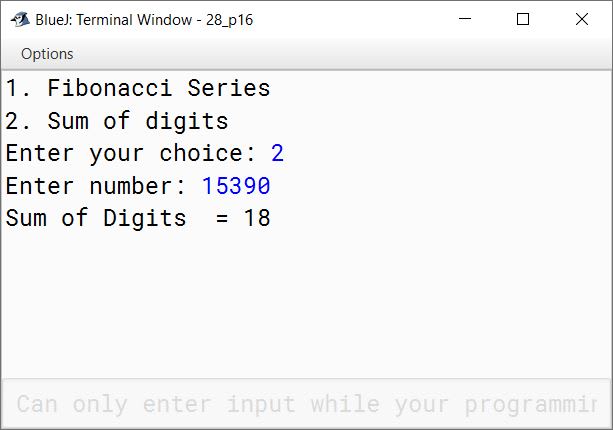Computer Applications
Using a switch statement, write a menu driven program to:
(a) generate and display the first 10 terms of the Fibonacci series
0, 1, 1, 2, 3, 5
The first two Fibonacci numbers are 0 and 1, and each subsequent number is the sum of the previous two.
(b) find the sum of the digits of an integer that is input by the user.
Sample Input: 15390
Sample Output: Sum of the digits = 18
For an incorrect choice, an appropriate error message should be displayed.
Java
Java Iterative Stmts
166 Likes
Answer
import java.util.Scanner;
public class KboatFibonacciNDigitSum
{
public static void main(String args[]) {
Scanner in = new Scanner(System.in);
System.out.println("1. Fibonacci Series");
System.out.println("2. Sum of digits");
System.out.print("Enter your choice: ");
int ch = in.nextInt();
switch (ch) {
case 1:
int a = 0, b = 1;
System.out.print(a + " " + b);
/*
* i is starting from 3 below
* instead of 1 because we have
* already printed 2 terms of
* the series. The for loop will
* print the series from third
* term onwards.
*/
for (int i = 3; i <= 10; i++) {
int term = a + b;
System.out.print(" " + term);
a = b;
b = term;
}
break;
case 2:
System.out.print("Enter number: ");
int num = in.nextInt();
int sum = 0;
while (num != 0) {
sum += num % 10;
num /= 10;
}
System.out.println("Sum of Digits " + " = " + sum);
break;
default:
System.out.println("Incorrect choice");
break;
}
}
}Variable Description Table
Program Explanation
Output



Answered By
32 Likes
Related Questions
Write a program to display all Pronic numbers in the range from 1 to n.
Hint: A Pronic number is a number which is the product of two consecutive numbers in the form of n * (n + 1).
For example;
2, 6, 12, 20, 30,………..are Pronic numbers.You can multiply two numbers 'm' and 'n' by repeated addition method.
For example, 5 * 3 = 15 can be performed by adding 5 three times ⇒ 5 + 5 + 5 = 15Similarly, successive subtraction of two numbers produces 'Quotient' and 'Remainder' when a number 'a' is divided by 'b' (a>b).
For example, 5/2 ⇒ Quotient = 2 and Remainder = 1
Follow steps shown below:Process Result Counter 5 - 2 3 1 3 - 2 1 2 Sample Output: The last counter value represents 'Quotient' ⇒ 2
The last result value represents 'Remainder' ⇒ 1Write a program to accept two numbers. Perform multiplication and division of the numbers as per the process shown above by using switch case statement.
Using switch statement, write a menu driven program for the following:
(a) To find and display the sum of the series given below:
S = x1 - x2 + x3 - x4 + x5 - ………………….. - x20
(b) To find and display the sum of the series given below:
S = ………………….. to n terms
For an incorrect option, an appropriate error message should be displayed.
Write a menu driven program to perform the following tasks:
(a) Tribonacci numbers are a sequence of numbers similar to Fibonacci numbers, except that a number is formed by adding the three previous numbers. Write a program to display the first twenty Tribonacci numbers.
For example;
1, 1, 2, 4, 7, 13, ………………….(b) Write a program to display all Sunny numbers in the range from 1 to n.
[Hint: A number is said to be sunny number if square root of (n+1) is an integer.]
For example,
3, 8, 15, 24, 35,………………….are sunny numbers.For an incorrect option, an appropriate error message should be displayed.